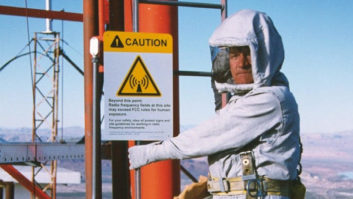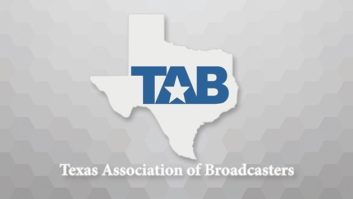Tower Safety Review
Jul 1, 2013 8:30 AM, By Jeremy Ruck, PE
It was once said that “working safely may get old, but so do those who practice it.” This is certainly true in our industry. Depending on which list you examine the danger rating of tower work floats. The minor differences in rankings between lists are merely semantics, as tower work is still regularly ranked in the top 10 most dangerous occupations. Although station personnel do not always have the same level of exposure as our friends who work at the heights, you are nevertheless exposed. Since we are all ultimately on the same team, safety truly is a cheap and effective insurance policy.

Typically tower crews are on the payroll of somebody else, and function as a subcontractor of the station licensee. This provides a certain degree of insulation for the licensee, but not entirely. Over the past several years courts have realized that the licensee, who acts as a general contractor, may not have control over the means and methods of the work being performed. Certainly you have the ability to order work stoppage, but actual control over the work goes deeper than that. If the licensee, or its representatives, retains supervision such that the contractor is not free to work in his own way, then you are definitely on the hook for whatever happens. As a result, it would make sense to extricate yourself from the day-to-day operations. While suggestions can be useful in getting the job done right the first time, offer them as suggestions and not demands or requirements.
Presumably before you even get to this point, you have taken numerous preliminary steps to ensure to the best of your ability that safety at your site will not become an issue. First and foremost, know your contractors. Most station engineers will be familiar with several companies that provide tower work at varying skill levels. Always hire the crew that is commensurate with the task at hand. For instance, hiring a crew that specializes in tower painting to install rigid transmission line may not be the best choice.
I have found most crews are like other professionals: They take pride in their work, and the top tier crews are really and truly craftsman despite the fact that they sometimes have colorful personalities. Their commitment to their trade, and especially safety, will be evident by the equipment and vehicles they use, and the condition in which they maintain the worksite. Careless maintenance and storage of tools, a safety hazard in itself, may sometimes indicate that safety is less of a priority than it should be.
In addition to the equipment, what sort of training has the tower crew provided for its employees? Has the company just provided its own on-the-job training, or has it sought outside certification? The former can sometimes perpetuate bad habits, whereas the latter, which does require an investment, hopefully mitigates the potential of safety problems downstream. Regardless of the method, employers are responsible to provide or accept appropriate training.
– continued on page 2
Tower Safety Review
Jul 1, 2013 8:30 AM, By Jeremy Ruck, PE
Make a plan
How robust is the safety plan in use at the site? If the contractor cannot provide you with a recent written copy of his safety plan, then the plan does not exist despite what is said to the contrary. One of the key elements of a plan is the safety meeting held each day at the start of work. Even if the work taking place is old hand, there is no excuse for not reviewing the hazards that may be faced that day. Such meetings keep the concept of safety in the front of the mind. As the licensee representative, you should make it a point to attend most, if not all, of the mandatory safety meetings.
While the tower crew will typically address safety issues for its employees, there are numerous things that need to be covered by the licensee or its representatives. The most common item that comes to mind is that of RF safety. Ensure that your RF safety plan is current before the crew arrives, and that it is rigidly enforced. Do not create deviations from the plan without concurrence by your consulting engineer. Similarly, do not allow the tower crew to play loose and fast with the safety plan. If it is too cold that night to work, then so be it. The days of hugging antenna elements to keep warm should be well past us by now.
Also on this list is tower maintenance itself. Just like regular maintenance on a vehicle keeps it in top shape, regular maintenance on towers keeps them in top shape. Absent from acts of God and other disasters, they will perform well for many years. Owners who invest in their towers only when a crisis or citation occurs should not be surprised if one day no crew will climb their structure.
Tower safety is also not limited to areas above grade. To work on the tower you have to first get to it. As tools and equipment tend to indicate the professionalism of a tower crew, the condition of your site reflects on you and your owner. If your site looks like a golf course, is clean and well maintained, then one can infer that all issues including safety are a priority. Conversely, the AM array that appears ripe for designation as a National Forest or Superfund site may indicate carelessness on your part.
Although there are numerous standards and laws in effect, it is important to remember that some of these merely provide minimum requirements. When we are dealing with the lives of others, and the livelihood of many, cutting corners should never be considered an option. The reality is, the few dollars potentially saved on the front end, can come back as an albatross on the back end. It truly is better to delay a project slightly, than to allow work to move forward that could result in damage to your facility, or worse injury or death to workers, yourself included.
In the end, much progress has been made over the years quantifying and mitigating the hazards associated with tower work. That being said, broadcasting in all of its technical phases is inherently dangerous work. While tower work may retain one of the top spots in the most hazardous occupation rankings, we should all strive to ensure that it does not displace fishing or logging. That is one area where a lower ranking is preferable, and that is where strict adherence to safety procedures will do its part.
Ruck is the principal engineer of Jeremy Ruck and Associates, Canton, IL.
July 2013
Check HD Radio Performance with Modulation Error Ration, a tower safety review, Field Report on the Inovonics 610, USB audio interfaces and a look back at 20 years of Radio magazine….












